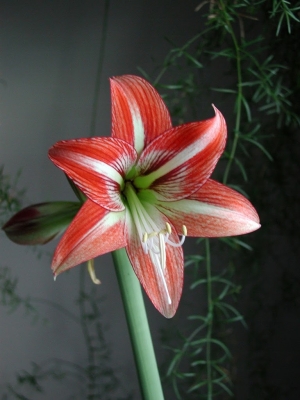Cold Rules
/9 Comments/in Gardening, Planning, Soil/by Lee ReichWater Freezes. Why Don’t Plants?
(The following is adapted from my book, The Ever Curious Gardener: Using a Little Natural Science for a Much Better Garden, available wherever fine books are sold, and my website.)
Not being able to don gloves and a scarf, or shiver, to keep warm, it’s a wonder that trees and shrubs don’t freeze to death from winter cold. They can’t stomp their limbs or do jumping jacks to get their sap moving and warm up. The sap has no warmth anyway.
Sometimes, of course, plants do succumb to winter cold. But usually that happens to garden and landscape plants pushed to their cold limits, not to native plants in their natural habitats or to well adapted exotic plants.
Think about it: water freezes at 32 degrees Fahrenheit—not a particularly cold temperature for a winter night—and plants contain an abundance of water. Water is unique among liquids in that it expands when it freezes, so you can imagine the havoc that could be wreaked as water-filled plant cells freeze and burst. Yet plants that must stand tall all winter do, of course, deal with frigid weather.
A Helping Hand for Herbaceous Plants
Herbaceous perennials (non-woody plants) opt for the easiest survival route.Their roots are perennial but their tops die back to the ground each year. Anticipate cold weather, these plants start pumping reserve nutrients to their roots in late summer. That’s why asparagus, cone flowers, delphiniums, and peonies are reduced, in autumn, to nothing more than a few dry stalks. 
What’s left of these plants spends a mild winter underground. Five feet down, the earth’s temperature hovers around a relatively balmy 50 degrees Fahrenheit.
Practical Rule #1: A thick blanket of some fluffy, organic material—leaves, straw, or wood chips, for example—further limits cold penetration.
Also for Woody Creepers
Low-growing, woody plants have it almost as good, with their stems shielded from the full brunt of cold winter winds. If Nature decides to throw down a powdery, white insulating blanket, so much the better: those leaves and low stems are protected even more. 
Practical Rule #2: In case Mother Nature is distracted with other activities, I provide my own low blanket for low-growing, woody or evergreen perennials—again, that fluffy cover of straw, leaves, or wood chips. Waiting to cover these plants until the weather turns relatively cold (soil frozen an inch deep is a good rule of thumb) lets plants acclimate to cold, and their stems and leaves have no chance of rotting beneath mulch that is still moist and too warm.
Tricks and Tips for Trees and Large Shrubs
What about trees and shrubs whose stems are fully exposed. One way they protect themselves from freezing is by shedding those parts most likely to freeze—their leaves.
Which introduces Practical Rule #3: I help plants along with their leaf shedding by letting plants naturally slow down and begin to reallocate their energy resources beginning in late summer. No water, fertilizer, or pruning at that time.
Of course, their stems still have to stand up and face the cold. Their living cells are filled with water. If this water freezes, the cells either dehydrate or suffer physical damage from ice crystals.
Water, whether in a plant cell or a glass, does not necessarily freeze as soon as the temperature drops below 32 degrees Fahrenheit. To freeze, water molecules need something to group around to form ice crystals, a so-called nucleating agent. Otherwise it “supercools,” remaining liquid down to about minus 40 degrees Fahrenheit, at which point ice forms whether or not a nucleating agent is present.
All sorts of things can serve as nucleating agents—bacteria, for instance—so plants may not be protected all the way down to minus 40 degrees Fahrenheit by having their water supercool. But winter temperatures don’t plummet that low everywhere, so just a bit of supercooling may be all a plant needs to survive winter cold.
Another trick, effective well below that minimum supercooling temperature, is for a plant to gradually move water out of its cells into spaces between the cells. As temperatures drop, ice crystals outside plant cells grow with the water they draw out of the cells; plants then are threatened by dehydration than by freezing. Plants toughest to cold are those that are best at reabsorbing the water outside their cells when temperatures warm. 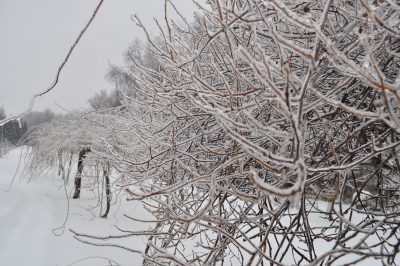
One other mechanism at work “freezing point depression,” which is why antifreeze keeps the water in your car radiator from freezing. Dissolving anything in water lowers the freezing point, more so the more that’s dissolved. As liquid in plant cells lose water, remaining water becomes more and more concentrated in sugars and minerals, its freezing point keeps falling.
Plants actively prepare for cold, with cell walls increasingly strong and and permeable. Light supplies needed energy for all this, making Practical Rule #4 to make sure to site and prune plants for adequate light.
Unfortunately, all this fiddling with a plant to help it through winter palls in the face of genetics. The very most that I can do to help plants face winter is to plant those that naturally tolerate the coldest temperatures winter is apt to serve up.
Get Crackin’
/11 Comments/in Fruit/by Lee ReichCured!
It’s finally time to get crackin’. Literally. Black walnuts are ready for shelling.
This nutty story goes back to early this past autumn as black walnut trees were shedding their nuts. The nuts fall in their husks, the whole package looking like green tennis balls. Lots of people curse the trees for littering lawns, sidewalks, and driveways. We, on the other hand, praise and collect the nuts.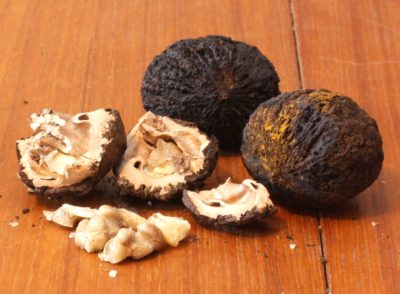
The first step to the present day crackin’ was husking the nuts. The soft, fleshy covering is easy to twist off the enclosed, hard-shelled nut. But we’ve also tried many methods to speed up the process, from spreading the dropped fruit in the driveway and driving over them to pounding them through a 1-1/2” hole in a thick piece of plywood to running them through a suitably modified old-fashioned corn-sheller.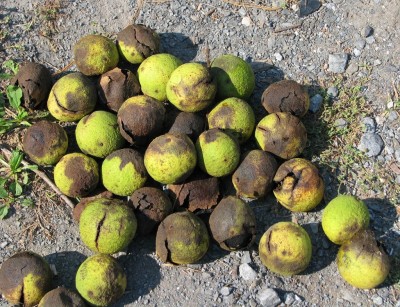

There’s no way around it: Husking black walnuts is a tedious job. And messy, because the soft flesh readily releases a juice which stains everything a deep brown color.
A friend recently told me of some novice black walnut enthusiasts that husked the walnuts bare handed, assuming the stain would wash off when they were finished. Not so. My wife Deb, who husks our black walnuts, chooses to sit herself down on a stool, don rubber gloves, and twist off the hulls, coaxing firm ones off with an initial tap with a light sledge hammer.
(The stain, which is colorfast and resistant to ultraviolet rays, is very easy to extract from the hulls for ink, for dyeing textiles, and staining wood. Just mix the hulls or unhulled nuts with water and boil for awhile or let sit a longer while. Strain and you’re good to go.)
In not too long, we had a number of 5 gallon bucketfuls of hulled nuts — a slimy, ugly mess from bits of hull still attached to the nuts and from the myriad white maggots crawling.
Now it was my turn — to clean up the nuts. I loaded all the nuts into shallow harvest boxes that had plenty of large holes for air or water and drove over to a nearby car wash. After suiting up in an old pair of rain pants, a rain jacket, rubber gloves, and a face shield, and spreading out the boxes on the ground in the car wash, I gave them a thorough, water-only cleaning.
I then spread the boxes out in the sun for a couple of days to dry out the surface of the nuts. Squirrels would be a serious threat but I spread the boxes on our south-facing deck where our two dogs also spend much of the day unknowingly guarding the nuts. Each night, or if any rain was predicted, I stacked and covered the boxes.
After the nuts were sufficiently dry, I stacked the trays in the barn where our cat is the squirrel deterrent.
Then the nuts needed to be cured, which involves nothing more than leaving them alone in a cool, dry, squirrel-fee area. And that brings us up to the present day.
A Tough Nut
Black walnut is a hard nut to crack. No run-of-the-mill nutcracker is up to the job. The usual tool, which is effective, is a hammer against the nut resting on an anvil or concrete. Used with care, a vise might do the job.
Two problems: With the hammer, hitting your finger occasionally as you hold the nut is inevitable. You could, I guess, hold the nut in a pliers. With either method, you have to use just the right amount of force to crack the shell sufficiently in order to extract the nutmeats in reasonable sized pieces without crushing everything too, too small.
The hands-down best job for cracking black walnuts is, in my opinion, the “Master Nut Cracker” (http://www.masternutcracker.com). It’s expensive but well worth the money for the speed with which the nuts can be cracked and the large nutmeats that result from efficient cracking. Besides which, it’s a very well-made tool with a very ingenious design.
Once nuts are cracked, nutmeats still occasionally need further coaxing to free them from the shell. A useful tool that I use that almost everyone has is a type of wire cutter sometimes called a diagonal cutting plier. The right squeeze in the right place, the result of observation and practice, yields large nutmeats that pop right out.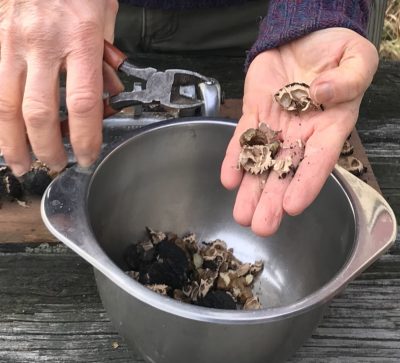
But Is It For You?
Black walnuts have a strong flavor that, like dark beer and okra, is loved by some but not enjoyed by everyone. But there’s no reason why everyone should like everything. Leave that goal to MacDonald’s. As L. H. Bailey, a doyen of horticulture, wrote back in 1922 (about apples), “Why do we need so many kinds of apples? Because there are so many kinds of folks. A person has a right to gratify his legitimate tastes.”
Black walnut is one of my favorite nuts. And, the trees and nuts abound around here, and elsewhere, free for the taking.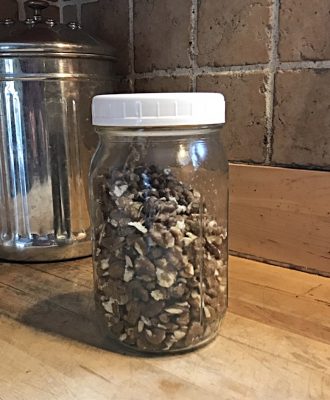
Gardening by the Book
/6 Comments/in Gardening/by Lee ReichAn outdoor temperature of 8.2 degrees Fahrenheit this morning highlighted what a great time winter is for NOT gardening, but for reading about gardening. A lot of gardening books, new and old, end up on my bookshelves, and I’d like to note a few favorites new to my shelves last year.
(Disclaimer: I had a new book published last year, The Ever Curious Gardener — available here. I like the book very much.)

For anyone serious about vegetable growing, Eliot Coleman, gardener extraordinaire, is the author to seek out. The Winter Harvest Handbook builds on his The New Organic Grower (recently re-issued to celebrate its 30th year since publication!) and Four Season Harvest, delving into innovative techniques for growing vegetables more efficiently and year ‘round, with minimum heat inputs even in northern climates.
The “aha” moment for me in reading Eliot’s method’s for year ‘round harvests was that sunlight, even this far north, is not limiting plant growth in winter. New York City and Madrid are at the same latitude! Mediterranean gardeners don’t abandon their vegetable gardens in winter; they just change plants, growing vegetables, such as spinach, lettuce, cabbage, and radish, that tolerate and enjoy cold weather. What we need on this – the cold side – of the big pond are ways to contain the earth’s heat and/or to provide heat efficiently to keep plants alive and growing. Read the book.
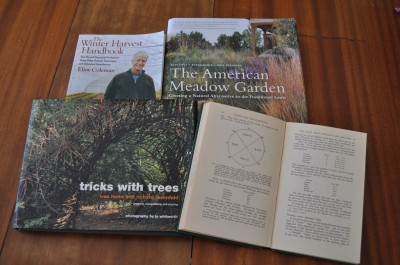
The title of the book Tricks with Trees, by Ivan Hicks and Richard Rosenfeld, doesn’t do justice to the neat things shown that people have done, and you could do, with trees. How about a tree trained as a chair, a living chair? Don’t expect to move such a chair anywhere because it’s rooted in the ground. One of my other favorites in the book is the “cloud seat.” (Use your imagination and you might guess what this is.)
People love the idea of meadows, perhaps because meadows seem low maintenance, perhaps because humans originated in the savannahs of Africa. Meadows have become very popular over the last few decades, and lots has been written about them. (I even have a meadow section in my book Weedless Gardening.) The American Meadow Garden, by John Greenlee, offers all you need to know and to grow a meadow. Saxon Holt’s photographs were so inspiring I contemplated turning my one-acre meadow into, well, more of a meadow. After seeing the photograph on page 41, I want shooting stars, a milkweed relative, in my meadow, which gets nothing much more than a yearly mowing.
Greenlee’s book does keep you grounded with plenty of information about the plants, about preparing the ground, and about maintenance, especially weed control. Maintenance? Weed control? Yes, a meadow, depending on your aspirations, may need both. My only beef with this book is that Greenlee makes no mention of mowing with a scythe, a most pleasant and very efficient tool for meadow maintenance.
Last, but certainly not least, is Science and the Glasshouse by William Lawrence. If the title sounds a bit old-fashioned, it’s because the book is old-fashioned; it was written in 1950. I visited Eliot Coleman this past summer and sometime during the visit we were lobbing titles of our favorite books back and forth. He threw me this one after I had lobbed to him Intensive Gardening, by Rosa O’Brien, also 1950 vintage and one of my favorite gardening books of all time (and one he had suggested to me back in 1973).
Back to Science and the Glasshouse, which I ordered asap, actually asaicgo (as soon as I could get online). My favorite thing about this book is that it challenges many commonly held notions by testing them scientifically. Mr. Lawrence, then head of the Garden Department of the acclaimed John Innes Horticultural Institute in Britain, subjected to scientific inquiry such beliefs as: cold soil is harmful to potted seedlings (it is not); crowding potted plants decreases growth of individual plants (sometimes); size matters, in pots for transplants (yes), and so on.
The second half of the book is devoted to the “glasshouse,” which greenhouses literally were back then. Mostly, his testing showed that plants in greenhouses did not always get all the light they should, not because of a lackadaisical old sol but because of dirty glass, poor orientation, and other things we can control. Which brings us around full circle back to Eliot Coleman’s capitalizing on winter sunlight.
Some Dirt Under the Fingernails
Okay, I am, in fact, doing a little gardening. I went down to the basement and brought 2 amaryllis plants upstairs to get them started growing for blossoms in February(?).
